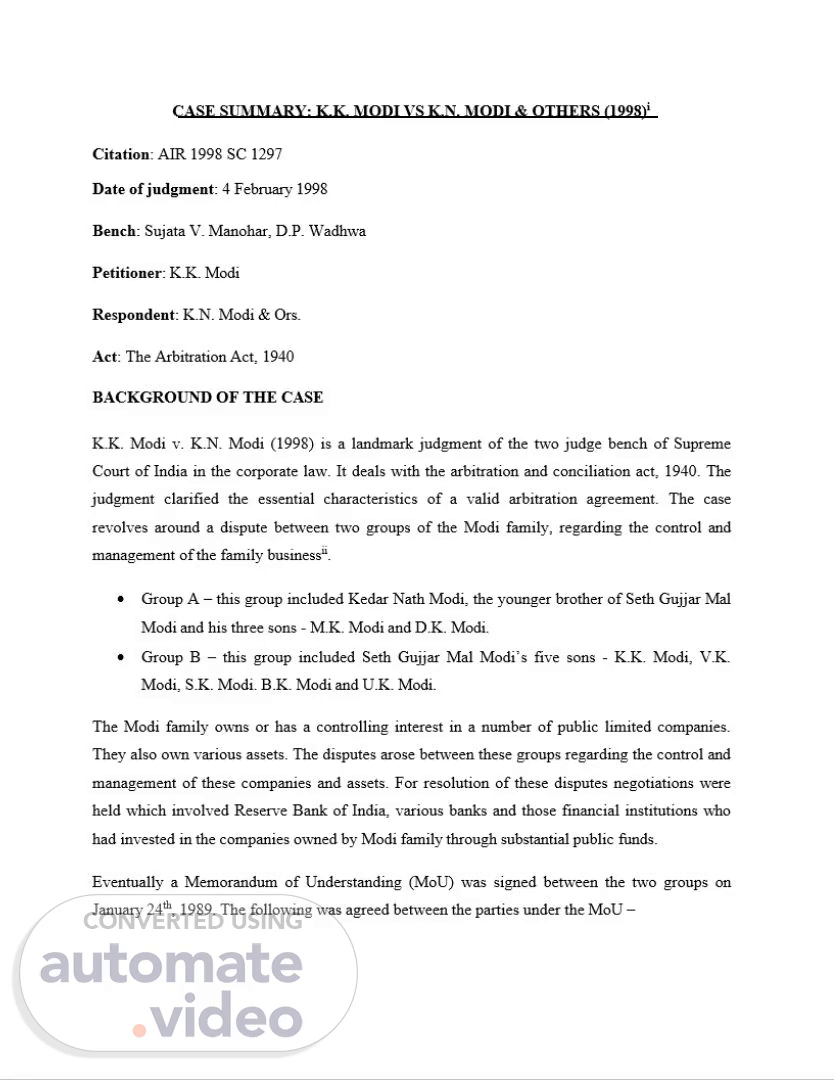Scene 1 (0s)
[Audio] The Supreme Court's landmark judgment underscores the critical role of clear language and intention to arbitrate in arbitration agreements. It stresses the necessity of explicitness and clarity in arbitration clauses to guarantee swift and effective dispute resolution..
Scene 2 (16s)
[Audio] Group A will manage and/or control the companies mentioned in Clause 1. One of the companies so included is Modipon Ltd. minus Indofil (chemical division) and selling agency. Group B is will manage and/or control the companies mentioned in Clause 2. One of the companies so included is Modipon Ltd. minus Modipon (Fiber Division). The agreement also provides that the assets are to be valued and divided in the 40:60 ratio between Group A and Group B respectively. The shares of the companies are required to be transferred to the respective groups after their valuation. Under Clause 3, valuation has to be done by M/s S.B. Billimoria & Company of Bombay. Clause 5 enumerates the companies which are to be divided between the two groups. The division has to be done under Clause 5 by a scheme of arrangement to be formulated by M/s Bansi S. Mehta & Company, Bombay after taking into consideration the valuation done by M/s. S.B. Billimoria & Company, Bombay. Units of a company to be given to each group are to be given along with assets and liabilities..
Scene 3 (1m 25s)
[Audio] The meetings took place between the Committee of Experts and the Chairman, IFCI, and both the groups. Meetings were also held with the chairmen of the concerned companies who were independent Chairmen. On December 8th, 1995, the Chairman, IFCI, gave his detailed decision. In this report, he gave some directions to both the groups. In his cover letter, the Chairman described this report as his decision on each dispute raised or clarification sought. He remarked that the members of both Groups should settle their family matter amongst themselves without any further reference to the Chairman and Managing Director of the Industrial Finance Corporation of India. On May 18th, 1996, an arbitration petition was filed by Group B under the Arbitration Act, 1940, in the Delhi High Court, challenging the legality and validity of the decision given by the Chairman of IFCI. The directions against the Chairman of Modipon Ltd. were also sought under this petition. A civil suit was also filed to challenge the same decision by Group B in the Delhi High Court on the same day. The averments and prayers in this suit were substantially the same as those in the arbitration petition. However, in one paragraph, in the plaint, it was stated that the same reliefs were being claimed in a suit in the event of it being held that the decision of the Chairman and Managing Director, IFCI, was not an arbitration award but was just a decision..
Scene 4 (2m 52s)
[Audio] The agreement between Group A and Group B provides that the companies mentioned in Clause 1 will be managed and controlled by Group A, while those mentioned in Clause 2 will be managed and controlled by Group B. Modipon Ltd., minus its chemical division and selling agency, falls under Group A, whereas Modipon Ltd., minus its fiber division, falls under Group B. The agreement also stipulates that the assets will be valued and divided in a 40:60 ratio between Group A and Group B, respectively. The shares of the companies will be transferred to the respective groups after valuation. According to Clause 3, the valuation will be conducted by M/s S.B. Billimoria & Company of Bombay. Clause 5 outlines the companies that will be divided between the two groups, and the division will be carried out according to a scheme of arrangement formulated by M/s Bansi S. Mehta & Company, Bombay, taking into account the valuation done by M/s S.B. Billimoria & Company, Bombay. Units of a company can be given to one group if necessary..
Scene 5 (3m 57s)
[Audio] The Supreme Court in this landmark judgment stressed the significance of using clear language and expressing a genuine intention to arbitrate in arbitration agreements. To achieve this, parties must clearly declare their desire to settle disputes through arbitration, and the agreement itself must be transparent, explicit, and unambiguous. This underscores the necessity for precision and clarity in arbitration agreements, thereby facilitating swift and effective dispute resolution without the need for protracted litigation..
